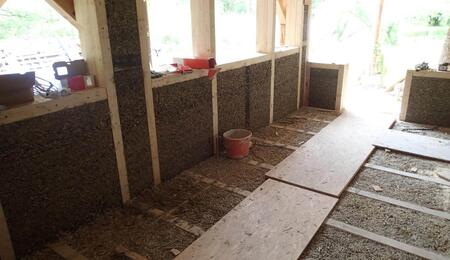Hemp! Build your own EKO home with hemp!

Interested in building your own home, easily, affordably and with a non-toxic, renewable material? Hemp will do it! Using the inner wooden core fiber from the hemp stalk combined with hydraulic lime and water creates a mixture to construct walls, ceilings, and floors with. Unlike regular cement, hemp homes include additional benefits like excellent thermal properties, high performance insulation, airtightness, yet are naturally breathing.
Hemp! Build your own EKO home with hemp!
The history of hemp Hemp has had a long and successful history as a multiple use, renewable resource. It is, in fact, the world´s oldest cultivated crop, including century-old uses for paper, textiles and oil. Shortly praised and promoted in USA propaganda films from 1942 like Hemp for Victory , where some of its army-related uses (as rope, fire-hoses, shoes, sails, parachutes) are highlighted, it was quickly pushed off the market for political-economic reasons . Today, it has about 25.000 registered uses , ranging from cosmetic products to bio-plastics, and car door panels to construction material. Hemp in construction Hemp is very interesting for the construction business, as it can be used in various ways, meeting many of today´s energy efficiency requirements in buildings.
Especially since “buildings account for almost one third […] of the total energy-related emissions of carbon dioxide (CO2) […] : material production and building assembly; building operational life […] building disassembly and subsequent disposal. Building with hemp can be CO2 negative because of carbon sequestration , as hemp uses more CO2 to grow than is necessary in the production process. Hemp fibers can be used as natural mold-resistant isolation material for in between walls. All the walls and ceilings in a building can be constructed from a hemp, hydraulic lime and water mixture, called hempcrete . It has shared properties with cement, but is easier to work with, and is friendlier to both the environment as well as the indoor climate, because of its natural breathability, which avoids sick building syndrome . Not only can the hemp necessary for building the walls be grown in months, (instead of years for trees) and with no mining necessary, and it can be fully recycled. If you demolish a hempcrete wall, you can mix it with lime and water again and reuse it to build a new wall, or crumble it up and plow it into the ground, providing basic fertilization.
Originating in France, the first ‘hemp house’ was built in the 1980´s and there have been thousands since, including big projects, like the 42-home scheme in the UK, discussed by Grand Designs host Kevin McCloud Hempcrete floors and walls in wooden framing The Czech Republic and self-built homes The Czech Republic has a long-standing tradition of people building their own homes. Especially in 70s and 80s it was very common for Czech people to self-build and these times seem to be returning. Apart from saving money, an important reason is quality: you know which materials have been used, and people building their own home build it to last for generations, not just until the construction warranty. Two Czechs, already working actively with hemp in construction professionally are: Patrik Majringer (Konopný beton) and Marek Šedivý (Konopné stavby). Patrik Majringer works with hemp full-time, providing know-how, realization of buildings, and lectures in association with the Czech technical university in Prague (CVUT) and the Brno University of Technology (VUT).
In his workshops, he combines theory and practice, explaining the application of hempcrete as well as having participants experience the process of creating floors, walls, and plaster hands-on. In the past, he built a career in managerial positions in the field of freight forwarding and logistics, as well as in construction and insulation of roof structures. Majringer was led to hemp due to a serious illness, and ten years ago, he began dealing with hemp as a building material and underwent a series of training courses in France and Belgium. He is co-owner of the company BIOHEMP, which grows hemp and supplies it for medicinal, food and cosmetic purposes, fibers for various industrial uses, and hemp shiv specifically for the creation of Hempcrete.
Majringer explains his choice for building with hemp: “Hempcrete is a material which, due to its unique properties, essentially has no competition. Proof of this is provided more and more through new research and tests in cooperation with renowned universities both in the Czech and Slovak Republic, but especially in France, which years ago, became the cradle of hemp building. " Patrik Majringer working on hempcrete outer walls Marek Šedivý is an IT specialist, who works with hemp part-time, provides consultation about hempcrete and its popularization, and is part of the organization of Konopex, a Cannabis fair in Ostrava, a smaller version of Prague´s popular Cannafest festival. Šedivý came to hemp through assisting his parents with the construction of their home, as he became interested in alternatives to regular building material.
He confirms to have found this in hemp. Šedivý explains that the advantage of hemp ¨is in the simplicity and the speed of realization. Except for the loadbearing wooden construction, all the parts necessary for the construction process are hydraulic lime, hemp hurd and water. According to whether you are building walls, a roof, or a floor, you only need to adapt the amount of hemp hurd in the mix. ¨ According to Šedivý, other advantages include no thermal bridges, the material being mold resistant, and providing an excellent indoor microclimate, due to the absence of chemicals (no glue nor foams necessary). Moreover, the hemp material necessary to build a home can be grown on two hectares of land. Marek Šedivý on top of his self-built hemp home rough framing construction
Author: Linda Veenman
References: [1] Building conservation. The Technology and Use of Hydraulic Lime. http://www.buildingconservation.com/articles/hydraulic/hydraulic.htm [1] United States Department of Agriculture. Hemp for Victory. https://www.youtube.com/watch?v=a1oFcgLfgV0 [1] Showcase 2. The real reason cannabis was prohibited. https://www.youtube.com/watch?v=0ebz9OuYLL0 [1] Science Direct. Energy and environmental assessment of industrial hemp for building applications: A review http://www.sciencedirect.com/science/article/pii/S1364032115005729 [1] Science Direct. Energy and environmental assessment of industrial hemp for building applications: A review http://www.sciencedirect.com/science/article/pii/S1364032115005729 [1] Wikipedia, the free encyclopedia. Hempcrete. https://en.wikipedia.org/wiki/Hempcrete [1] National Health Service. Sick building syndrome. http://www.nhs.uk/Conditions/Sick-building-syndrome/Pages/Introduction.aspx [1] Excerpt from Bringing it home. Hempcrete housing estate in the UK. https://www.youtube.com/watch?v=sVlYDWr31fQ [1] Echo 24. Jako za socialismu. Češi se bojí dluhům domy si staví svépomocí (As under socialism. Czechs are afraid of debt and are building their homes themselves.) http://echo24.cz/a/iJwtE/jako-za-socialismu-cesi-se-boji-dluhu-domy-si-stavi-svepomoci [1] Eurozprávy. Češi si stavějí domy sami, kašlou na developery. Jaká je úspora? (Czechs are building their homes themselves, they do not care about developers. What are the savings?) http://ekonomika.eurozpravy.cz/ceska-republika/77462-cesi-si-staveji-domy-sami-kaslou-na-developery-jaka-je-uspora/ Patrik Majringer – Konopný beton http://www.konopny-beton.cz/ Marek Šedivý – Konopné stavby http://www.konopnestavby.cz/



